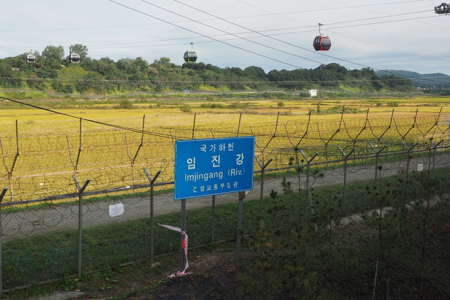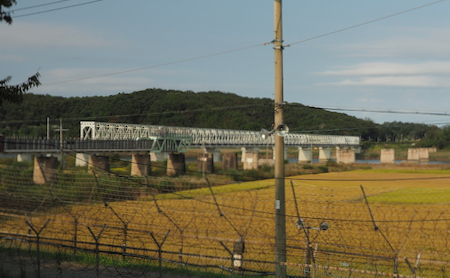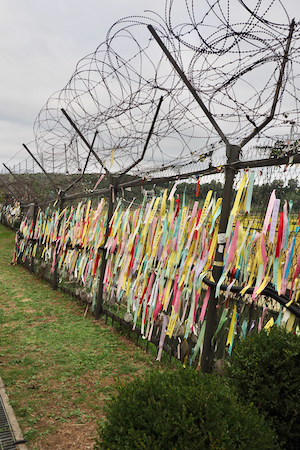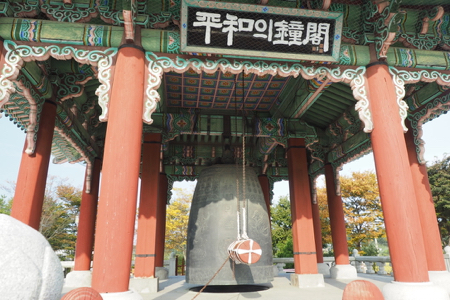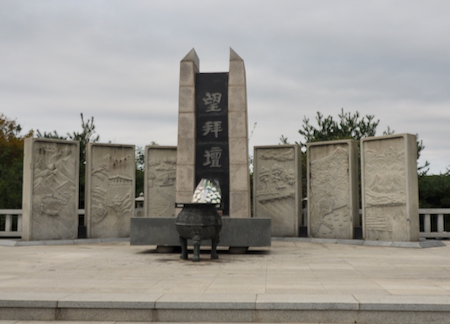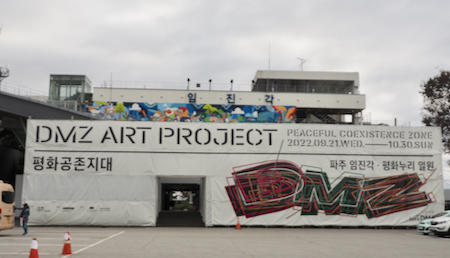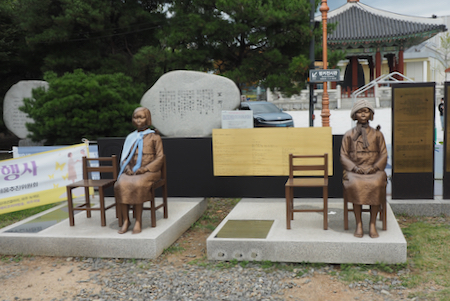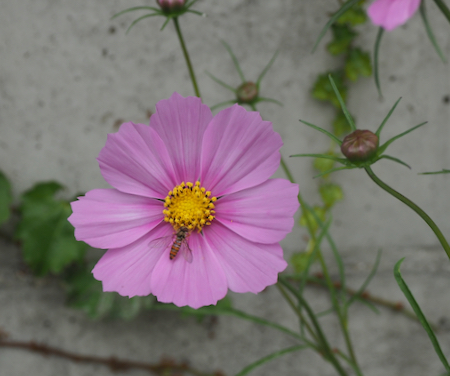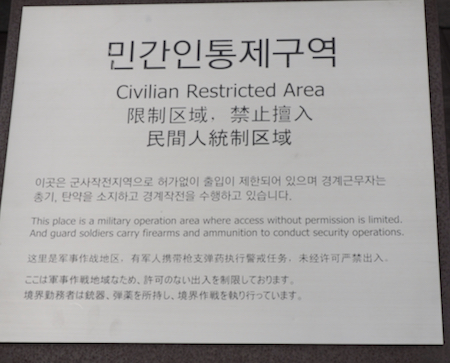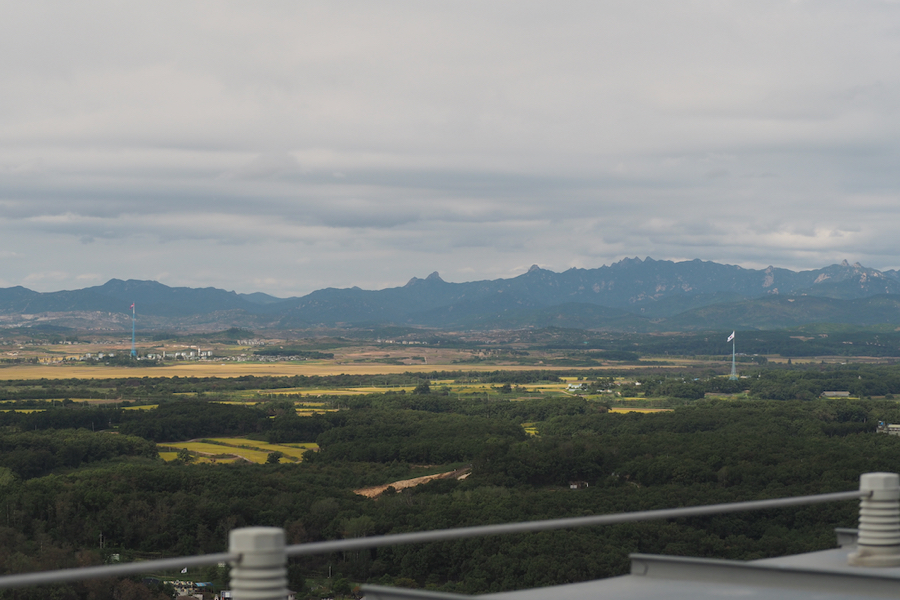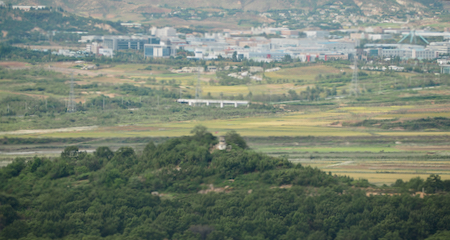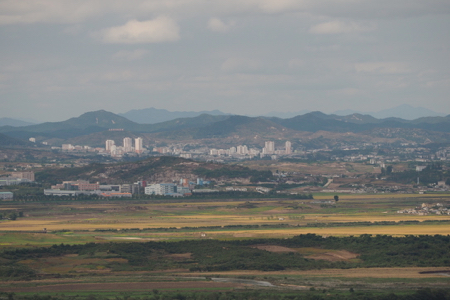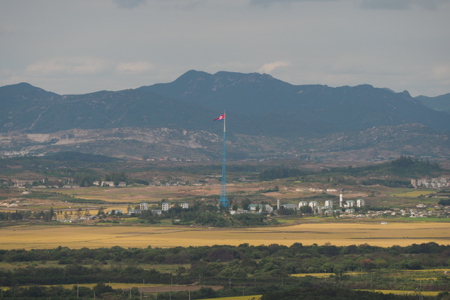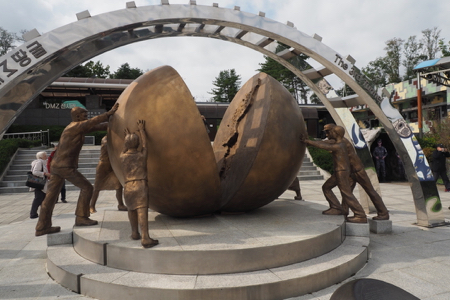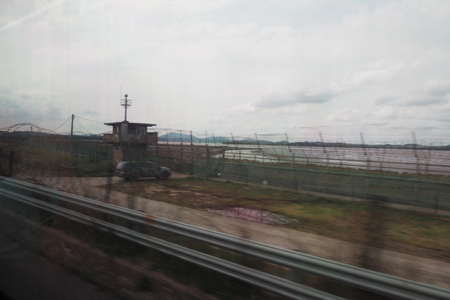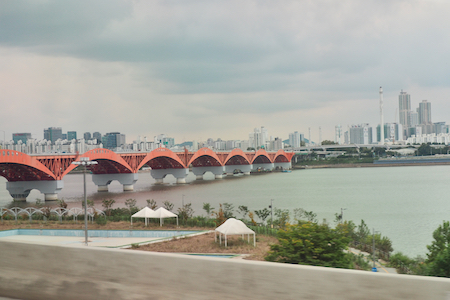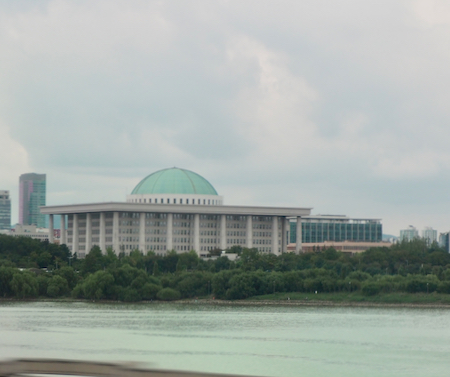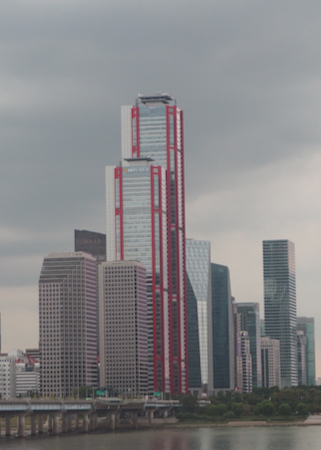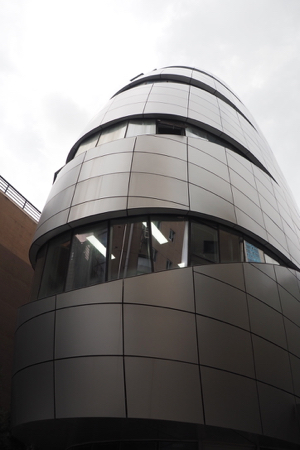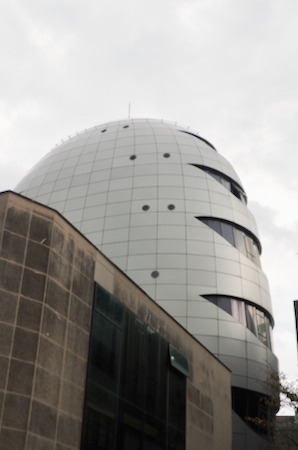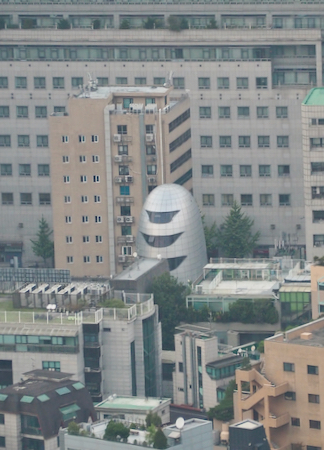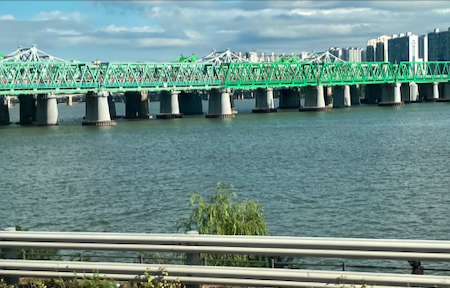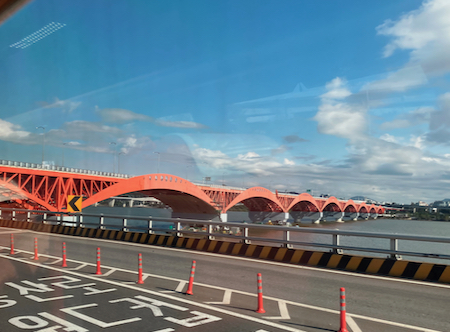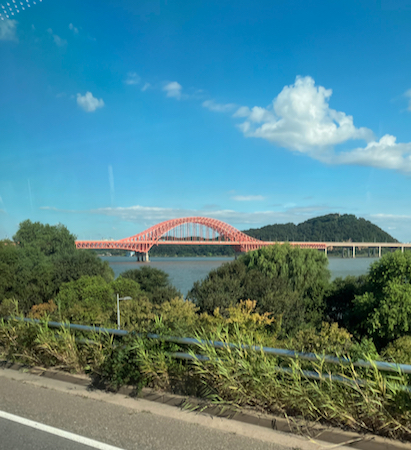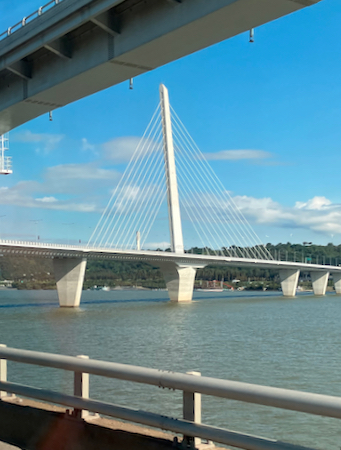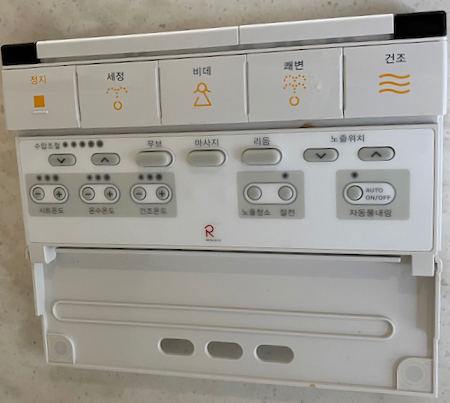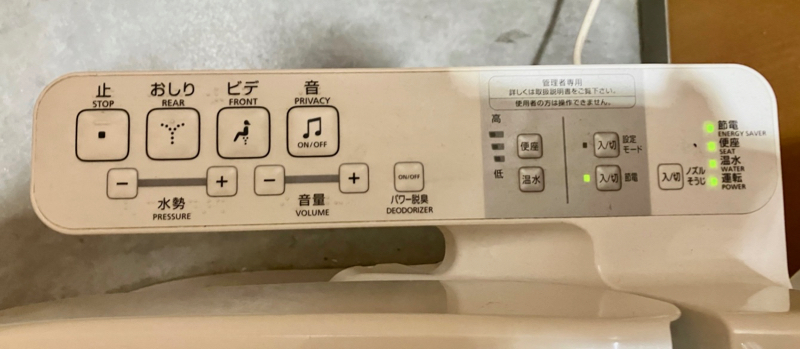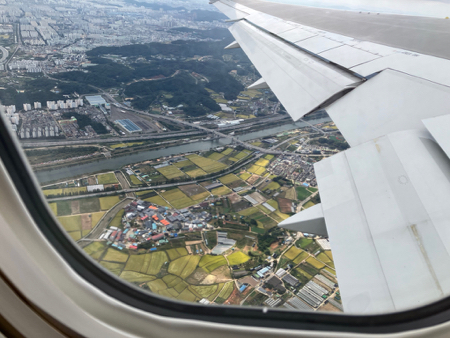Thurs., 10/6 - DMZ Korea
This morning, early, the group bussed north to the Demilitarized Zone (DMZ) separating South and North Korea. After arriving, Pam waited in line for almost an hour with all of our passports to get tickets for the monorail into Tunnel 3 and up to the Observatory at the DMZ. While waiting, we wandered the area of Imjingak Park and looked at the Peace Bell of 2000 and the remains of a locomotive full of bullet holes that once crossed the DMZ area. The tracks and destroyed bridge over the Imjin River are still viewed from a platform.
Display in the museum - Korean history
Looking out at the DMZ
Imjingak bridge over the Imjin River
Looking out from the end of the destroyed Peace Bridge
Prayer flags for unification
Peace Bell Pavilion
Peace Bell - built in 2000 to pray for peace of the human race and national unification in celebration of the new millennium
Bullet-riddled steam engine is a symbol of the Korean War
Mangbaedan Memorial Altar - where people who left North Korea visit and perform ancestral rites by bowing toward their hometown every New Years Day and during the festival of Chuseo
The REAL DMZ PROJECT (RDP) was conceived in 2011 to explore the (in)visible borders of the DMZ through the critical lens of contemporary art and to raise awareness about the division of Korea.
Comfort Women monument - the two women sitting on chairs with bare feet with hair cut short represent the Korean women used as Japanese military sex slaves (“comfort women”) during the Japanese occupation, an ugly time in Korean history.
Sign at the DMZ
At 10 AM the group boarded the DMZ Control bus and crossed the Civilian Access Control Line. Two young Korean soldiers came on the bus to check passports. The bus crossed the “Cow Bridge” over the Imjin River.
The monorail goes down 73 meters to a location where visitors can walk in Tunnel 3. (No photos allowed.) This was the third tunnel discovered by the South Koreans. The north was digging tunnels in order to storm Seoul in the 1970s. 30,000 troops and equipment could have gotten through the tunnels in one hour. The North denies building them, saying they were coal mines. There is no coal in the granite there and the North put black powder on the walls to make it look like coal. The tunnel is two meters high and two meters wide and slopes down to the north for drainage. We walked in the tunnel, mostly bent over because the supports are very low (often less than 5.5 ft.), to the obstruction gates. Thankfully, helmets were provided.
After the tunnel experience, the group was taken to the observation area to look out over the DMZ into North Korea.
Looking across the DMZ: the flag of North Korea is on the blue pole to the left and the flag of South Korea on the white pole to the right
Looking into North Korea
Looking into North Korea
Looking into North Korea
Statue of Brothers at the War
Barbed wire and sentry post along the DMZ border
On the way back to Seoul, we stopped for a lunch of Bul Gogi to have tender marinated beef, onions, and mushrooms on rice that we cooked at our table. It was delicious.
Seongsan Bridge over the Han River
National Assembly Building
Parc1 Building
63 Square building
At 4:30 we had a discussion with a North Korean defector/refugee. She is sponsored as a speaker with an organization called Freedom Speakers International to Empower NK Refugees. She presented her story to us in English and we asked many questions which a translator answered for us.
After the discussion, we went for a stroll around the neighborhood to find and photograph the strangely shaped building below.
Cute sign
Interesting building
Haven't been able to find the name
Side view
View from the Seoul Tower
Fri., 10/7 - South Korea to Japan
On the way to the airport, Pam provided some interesting trivia: there are still restaurants in Seoul and South Korea that serve dog meat. Korea is almost drug free, though marijuana is beginning to appear. We passed a Trump Tower. He doesn’t own it. They pay him to use his name. The Unification Church is a huge, rich concern in South Korea and is not taxed. Korea has 10 major baseball teams.
Hangang Bridge
Seongsan Bridge over the Han River
Banghwa Bridge
Godeok Bridge
The toilets in South Korea and Japan, whether public or in a hotel room are nearly all a combination toilet and bidet. The controls are found either on an arm attached to the seat or on the adjacent wall. Location depends on the manufacturer/model. Sometimes you are lucky and the symbols are also identified in English, and sometimes not. The seats are invariable heated. Sometimes the flushing mechanism is a little obscure. Pushing the wrong button, especially in a public toilet, could lead to disaster/embarrassment.
The public toilets in both countries are immaculate! In Japan, there tends to be a control marked "privacy" that when activated plays a sound or music to cover the sounds of you doing your business.
The controls are described below. My mother would have said you need a college degree to go to the toilet. I would add that the Google Translator app is very useful!
Typical South Korean or Japanese toilet/bidet - controls are on the wall.
This one has a water faucet that you can use to wash your hands - the water then goes into the tank to be used when flushing - nice water saving feature if you can reach the faucet.
Wall control - Korean toilet
Row one: Stop; Washing (Rear); Bidet; Pleasure; Dry
Row two: Water pressure control; Move; Massage; Rhythm; Nozzle position
Row three: Seat temperature; Hot water temperature; Drying temperature; Nozzle cleaning; Power saving; Automatic flush
The above controls are on an arm attached to the toilet seat - sometimes difficult to see - Japanese toilet
On the left: Row one: Stop; Buttocks (Rear); Bidet (Front); Sound (Privacy)
Row two: Water pressure (Pressure); Volume (presumably of the sound); Deodorizer
The shaded area in the middle section is labeled "For administrator's only . . .". The controls on its left side are for Seat (top) and Water (bottom) temperature and the two buttons to the right are titled Mode (top) and Power Saving (bottom).
The right-most section (with the lights) : Single control on the left of the section is for Nozzle Cleaning; the lighted buttons indicate (top to bottom): Power Saving; Seat; Hot water; On/Off
Departing Seoul
The flight from Seoul to Tokyo, Japan, was a 1 1/2 hour flight on Nippon Air. They served us a “chicken sandwich” which was fried chicken chunks in a soft bagel and a bag of caramel popcorn.
| Return to Top | Return to Itinerary | Return to Trips page to view other trips | Return to Dreamcatcher Home Page |


